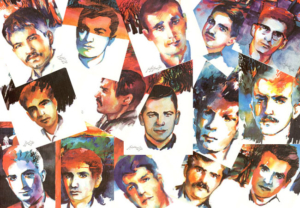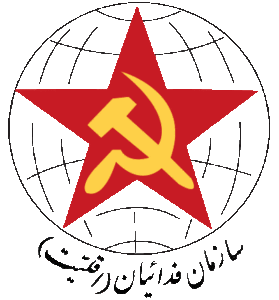A brief history of organisation of Fadaian (Aghaliyat)
 At the same time as the growth of capitalist relations at the end of the 19th century and the beginning of the 20th century, the Iranian working class started to grow. Despite all the obstacles and limits which imperialism and international finance capital had put on the “free” and rapid developement of capitalism in Iran, their influence has caused the capitalist alteration process to take place at a slower rate and the Iranian working class had already grown by the beginning of the 20th century. The first trade unions were founded at the same time during the bourgeois-democratic revolution in Iran called “The Constitutional revolution (1905 – 1911)”. The first social democratic cells appeared at this time, and social democratic circles were formed.
At the same time as the growth of capitalist relations at the end of the 19th century and the beginning of the 20th century, the Iranian working class started to grow. Despite all the obstacles and limits which imperialism and international finance capital had put on the “free” and rapid developement of capitalism in Iran, their influence has caused the capitalist alteration process to take place at a slower rate and the Iranian working class had already grown by the beginning of the 20th century. The first trade unions were founded at the same time during the bourgeois-democratic revolution in Iran called “The Constitutional revolution (1905 – 1911)”. The first social democratic cells appeared at this time, and social democratic circles were formed.
Despite the modest numbers of the industrial proletariat, the fact which helped to stimulate the socialist- marxist tendencies and increase the consciousness of the working class, was the Iranian workers connection with the Russian social-democratic movement at the start of this century. Every year, a large number of Iranian workers travelled to Russia in order to find a job and many found work with the Baku oil industry. They became acquainted with Marxism and the organised movement of the proletariat in Russia. When they later on returned to Iran, they continued with their activities as “conscious workers”.
The socialist “October revolution” played a considerable role in organising and awaking Iran’s working class. The communist party of Iran held its first congress in 1920 and officially started its activities. The communist party of Iran, (a Marxist-Leninist party) and member of the Third International, played an outstanding role in developing the consciosness of the working class and its organisation. It was in this period, that the trade union movement extended. Many strikes were carried out in order to improve the living conditions of the working class. In addition to its economical struggle, the Iranian proletariat also started a political struggle against the reactionary ruling classes.
The reactionaries finally won after a series of political and military confrontations. Trade unions and the communist party were outlawed, and the established policy of repression resulted in the dissolving of the communist party. There was no official communist party in Iran after 1929.
During the Second World War and after the allies had occupied Iran and the yoke of the Reza Shah regime was deposed, a party called the “Tudeh party” (the mass party) was founded in Iran. This party, which was backed by the Soviet Union, claimed to have confidence in Marxsit-Leninist principles and defend the interests of the workers. However, in reality the party was neither Marxist nor Leninist and did not defend the workers’ interests. It was more akin to a petty-bourgeois opportunist group. It not only proved this fact with its ideological-political standpoints, but also with its practical applications of these standpoints.
This party, which was a symbol of opportunism and submissiveness, refrained from any revolutionary action under the CIA-planned coup in Iran in 1953 (*), despite the fact that it had a significant organised force under its control. Shortly after the victory of this coup the party organisation was also crushed.
The role of the Tudeh party in the defeat of Iran’s revolutionary movement, the betrayal of the party leadership to its members, the arrested leaders support of the Shah’s regime after the CIA coup, the collaboration of these leaders and a group of the party’s top cadres with the Shah´s regime and with its secret police (Savak), and finally the repentance statements, which a large number of the arrested published all had a very negative effect on the Iranian people and their judgement of communists.
Although the Tudeh party was not a Marxit-Leninist party, it had declared itself as one and had had the support of the Soviet Union. Therefore the communists were accused instead of the party of being traitors by the party. Workers and toilers lost their faith in the communists, and a desperate and hopeless atmosphere prevailed in the mass movement.
There were not any significant activities by the communists after the Tudeh party’s defeat. The few communist groups, who were founded during the period after the defeat, could neither have any influence nor preserve their continuity. These groups were either dissolved or arrested by the secret police of the Shah’s regime.
The situation remained the same until a group of workers and Marxist-Leninist revolutionary intellectuals were gathered. They had a clear dividing line from the Khruschevist revisionism, from the Tudeh party as an opportunist-reformist party and finally from the Chinese sympathizers. They believed in revolutionary handlings in order to put an end to the dominated passivism and standstill situation and concluded that the ruling class of Iran should be fought using a combination of political and military methods.
The birth of this line was officially declared on 8th February 1971 with an armed assault on a gendarmerie post in “Siahkal” in the northern part of Iran. Our organisation – The Organisation of Iranian People’s Fedaii Guerillas – (OIPFG) – was founded as a result. From that time until the overthrow of the Shah´s regime, the OIPFG was in fact the only active Marxist-Leninist organisation in Iran.
The Shah´s regime mobilised all of its organs of supression to crush this new movement, which in reality was a starting point for the Iranian communists new activities. Our comrades were executed in groups. Everyone, who had even a little sympathy for the OIPFG was sentenced to long term imprisonment. A hard period supression took place, attempting to crush the newly formed “organisation”. Although hundreds of our comrades were murdered and thousands sentenced to jail during the first 7 years of The OIPFG’s existance the efforts of the Shah’s regime failed. The OIPFG’s revolutionary activities, and struggle against the “workers´ enemy” gave new credibility to the communists.
The influence of the OIPFG on the workers, toilers and revolutionary intellectuals increased day by day to such a high degree, that after the overthrow of the Shah´s regime, the OIPFG became the largest revolutionary Marxist-Leninist organisation in not only Iran, but also the Middle East.
The OIPFG played a considerable role in the workers organisation and in the development of their consciousness. But at the same time some disagreements arose in our organisation. And thus two opposing tendencies were created in the OIPFG. The disagreements of these tendencies focused on 3 points:
* The assessment of the class-content of the new regime, which took power after the February insurrection in 1979, and our attitude towards it;
* Our attitude towards the Soviet Union;
* The assessment of the OIPFG’s past and its former political line;
One tendency, namely the right-wing, deviated from the marxist-leninist and anti-revisionist standpoints of the OIPFG, and moved closer to the revisionist attitude of the”Socialist camp” led by the Soviet Union. This tendency therefore approached the lines of Tudeh party, which was backed by the Soviet Union. The tendency, in accordance with its revisionist points of view, assessed the Islamic Rebublic as a pett- bourgeois, revolutionary, anti-imperialist regime. It asserted that any armed struggle against the Shah´s regime, which had been carried out by the OIPFG, was wrong.
On the other hand the left-wing tendency stressed the Marxist-Leninist and anti-revisionist standpoints of the OIPFG and its dividing line with the Soviet Union. This section considered the Islamic Republic to be a bourgeois-religious, reactionary, and antirevolutionary regime. It therefore proposed, that the people should be organised to overthrow the Islamic Republic.
Finally, the left tendency, concerning the former political attitude of the OIPFG, emphasized that although they had some errors in form when accentuating the armed struggle in proportion to the political struggle and mass organisation, the OIPFG’s past couldn’t be denied in its entirety. Now we should concentrate on the organisation of the workers and the developement of their consciousness.
These disagreements finally ended with a comprehensive split among the OIPFG in 1980. The right-wing, which was advocated by the majority of the OIPFG’s central comittee, was called the “Majority”, and the left-wing, which was advocated by the Aghaliyat of the central comittee, was called the “Aghaliyat”. While the “Majority” allied with the Islamic Republic, backed its reactionary policies and eventually changed into a bourgeois-liberal current, the Organisation of Iranian People’s Fedaii Guerillas – (Aghaliyat) undertook to defend Marxism-Leninism, internationalism and to support the ideals and interests of the working class.
The reactionary regime of the Islamic Republic, which could not tolerate the revolutionary activities of the OIPFG, put a policy of repression at the top of its agenda.
Most of the OIPFG’s leaders were murdered during 1981, and a large number of its members and sympathizers were either imprisoned or murdered by the “hangmen” of the Islamic regime. Since 1981 the Islamic Republic has continued to prosecute and arrest hundreds of the OIPFG’s members and sympathizers, who have been either executed or have been given long prison sentences. But the OIPFG has continued – and is still going strong.
Despite the comprehensive damages it has suffered from the Islamic regime, the OIPFG continues to carry out its revolutionary duties with a faithfulness to its communist aims and ideals.
The Organisation of Fadaian (Aghaliyat)(**) defends proletarian social revolution in the whole world and believes, like any other Marxist-Leninist and internationalist organisation, that the present stage of the developement of capitalism is the stage of imperialism. It has therefore brought the contradictions of capitalism to their highest extent. This epoch – the epoch of imperialism – has prepared all of the necessary objective conditions for the implimentation of the proletarian revolution. Therefore the establishment of the dictatorship of the proletariat, the abolition of the private property and the establishment of the social property to the means of production, are the immediate task of the proletariat of the whole world. The Organisation of Fadaian (Aghaliyat) defends the immediate establishment of a Soviet-state in Iran.
———————————————————————–
* Coup : In 1953 a military coup took place in Iran, which was organised by the CIA. With this coup Dr. Mohammad Mosaddeq, Iran´s Prime Minister, who nationalised the Iranian oil industry and wanted to limit the power of Shah and court, fell from power. After that the Shah came back to power as an absolute monarch.
** In 6th conference of the O.I.P.F.G.(Aghaliyat) on Jan. 1997, the name of the organisation changed to Organisation of Fadaian (Aghaliyat).


